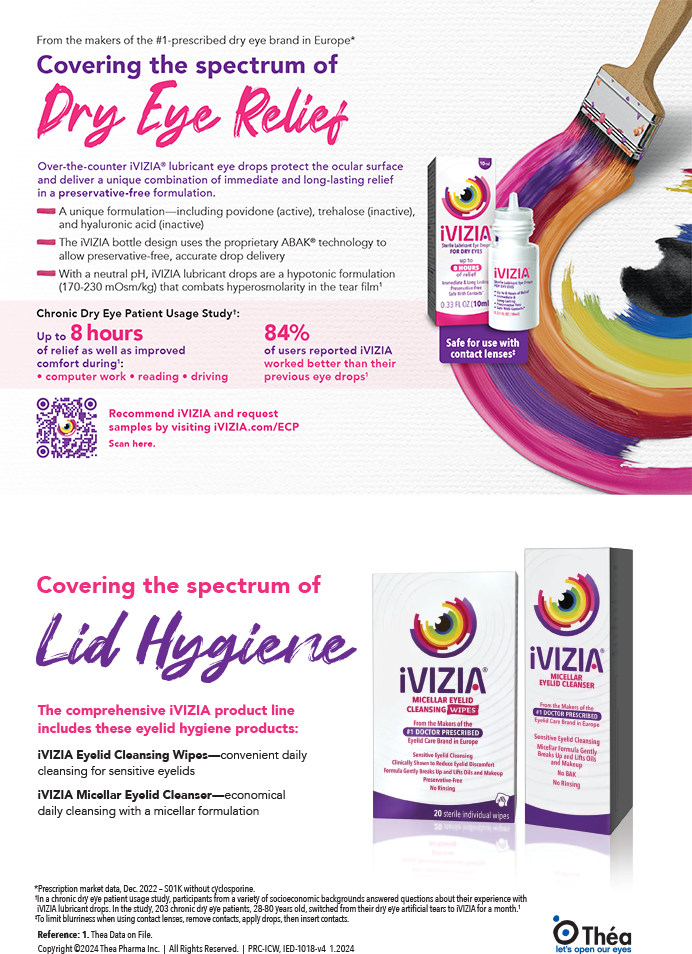National and international concerns continue to mount over the rise of so-called “superbugs,” or antimicrobial-resistant bacteria. Concerns regarding increasing levels of microbial resistance in bacteria are not new, and in eye care this debate dates as far back as when the Ocular Tracking Resistance in US Today (TRUST) studies were conceived.1,2
The reality is that few if any new antimicrobial drugs are being licensed or developed, and managing superbug infections remains a growing challenge as existing molecules are proving to be less effective at managing these bacteria. It is time to look beyond monitoring the mechanisms of bacterial adaptation and start a conversation regarding factors such as physicians’ clinical behavior and the variability of available drugs, both of which contribute to this emerging and accelerating problem.
The variability found in generic antibiotics is not often discussed, but it may be a potential contributor to the phenomenon of bacterial resistance. The possible contributory role of generics in the development of bacterial resistance has been previously voiced.3
We cannot determine the relationship between the rise of generic antibiotics and the potential contribution of these less-regulated entities to the issue of antimicrobial resistance because we do not have scientific data that suggest a link. However, we also cannot discount this possibility. Perhaps, in a small but significant manner, these compounds are partially contributing to the rise of the superbugs.
Generic drug use accounts for about 80% of prescriptions, and generics are an integral part of eye care. These compounds are easily accessible, at times much less expensive than their branded counterparts, and often a requested alternative by patients under the assumption that they are equal in efficacy and safety to the branded drugs.4,5
Might it just be a coincidence that, because of the accessibility, frequency of use, and cost of these generic agents, we are seeing more resistance to the medications that are available as generics? The most recent Antibiotic Resistance Monitoring in Ocular Microrganisms (ARMOR) report noted increases in antimicrobial resistance in many of the isolates tested. Notably, Pseudomonas aeruginosa isolates more than doubled their ability to fend off ciprofloxacin, a staple antibiotic that has been used in topical ocular and systemic formulations for many years.6
Should we be suspicious of the use of generics? It is worth noting that generic manufacturers are not required to be as stringent in their formulations, as variations are allowed in inactive ingredients and larger variations in the analytical formulation.6 Generic formulations do not have to adhere to strict guidelines for effectiveness as branded drugs do, and, unlike branded products, clinical trials are not required for their approval.
A study comparing various generic formulations of ciprofloxacin showed variation by as much as 20% in potency.7 There is no current requirement for generic manufacturers to demonstrate antimicrobial efficacy; they merely have to show the equivalency of the ingredients in their products to their branded counterparts.8,9
With the continued rise of bacterial resistance, should these variations be a professional concern? It is questionable whether the antimicrobial efficacy of a generic agent, such as a topical ophthalmic solution, is equivalent to that of its more controlled and reproducible branded counterpart.
The therapeutic healing process depends on sound scientific knowledge and a trust that the offending agent will be best managed by effective antimicrobial medications. Most prescribing physicians rely on empirical prescribing, as cultures are not routinely performed, and prophylactic treatment relies on the assumption that a given medication is effective in actively managing potential pathogens. With uneven regulatory oversight, lack of evidence-based microbial efficacy metrics, and low costs to consumers for generic drugs, and with market forces making the development of new drugs a financial challenge, medical professionals should be concerned. We must be conscious of our role in managing antimicrobial usage, our use of generic medications, and the ever-increasing threat of antimicrobial-resistant superbugs. n
Mel Friedman, OD
• private practice at For Your Eyes Only in Memphis
• dfried007@aol.com
Agustin L. Gonzalez, OD
• optometric glaucoma specialist and therapeutic optometrist in practice with Eye & Vision in Richardson, Texas
• ag@txeyedr.com
1. Ta CN, Sahm DF. Methicillin-susceptible Staphylococcus aureus and methicillin-resistant Staphylococcus aureus: findings of Ocular TRUST. Poster presented at: American Society of Cataract and Refractive Surgery (ASCRS)/American Society of Ophthalmic Administrators (ASOA) Symposium; April 27-May2, 2007; San Diego, CA.
2. Asbell PA, Sahm DF. Longitudinal nationwide antimicrobial susceptibility surveillance in ocular isolates: results from Ocular TRUST 2. Presentation at: ASCRS/ASOA Symposium; April 4-9, 2008; , Chicago, IL.
3. Fitch R. Generic antibiotics, antibiotic resistance, and drug licensing. Lancet Infect Dis. 2010;10:754.
4. CBS Health News. http://www.cbsnews.com/stories/2007/08/07/health/main3140185.shtml. Accessed October 25, 2014.
5. Babar ZU, Stewart J, Reddy S, et al. An evaluation of consumers’ knowledge, perceptions and attitudes regarding generic medicines in Auckland. Pharm World Sci. 2010;32(4):440-448.
6. Sanfilippo CM, Morris TW, Deane J, et al. Antibiotic resistance profile of ocular pathogens – an update from the 2013 US ARMOR Surveillance Study. Association for Research in Vision and Ophthalmology (ARVO) Annual Meeting; May 8, 2014; Orlando, FL.
7. Weir RE, Zaidi FH, Charteris DG, et al. Variability in the content of Indian generic ciprofloxacin eye drops. Br J Ophthalmol. 2005;89(9):1094-1096.
8. Narayanaswamy A, Neog A, Baskaran M, et al. A randomized, crossover, open label pilot study to evaluate the efficacy and safety of Xalatan in comparison with generic Latanoprost (Latoprost) in subjects with primary open angle glaucoma or ocular hypertension. Indian J Ophthalmol. 2007;55(2):127-131.
9. Cantor LB. Ophthalmic generic drug approval process: implications for efficacy and safety. J Glaucoma. 1997;6(5):344-349.


